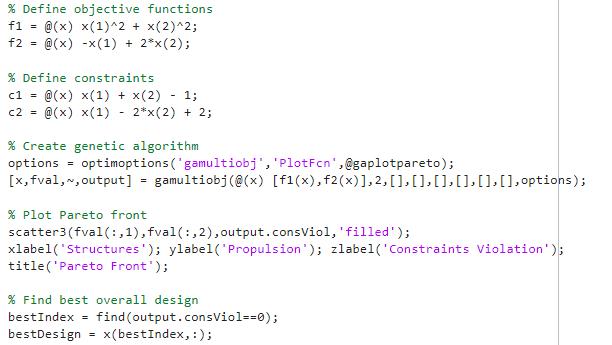Question
Hi would it be possible please for someone to adapt my multi objective genetic code in matlab in order to minimize and maximize the functions
Hi would it be possible please for someone to adapt my multi objective genetic code in matlab in order to minimize and maximize the functions and equations established here with these constraints in order to appear an 3D Pareto front ? Do not worry about these values as they are simply for testing.
The project is called optimization of a turbojet afterburner two spool engine
My code unfortunatelly is only for 2D yet.
Thank you so much, I've been stuck here for a long time
The idea is to see in 3D Pareto front maximizing and minimizing the functions in relation to the constraints and to opt for the best overall design.
If it is also possible to establish realistic values for the variables and equations I would be very grateful.
%variables and random values
f=1; % f= fuel to air ratio
Fn=2; % Fn= net thurst
m0=3; % m0= air mass flow rate
p3=4; % p3=inlet pressure
Tpz=5; % Tpz=primary zone temperature
o=6; % o=equivalence ratio
t=7; % t=residence time
aa=8; % aa=pressure term
WTO=9; % Wto=take off weight
WLanding=10; % Wlanding=landing weight
WF=11; % Wf=fuel weight
WE=12; % WE=empty weight
WPL=13; % Wpl=payload weight
WC=14; % Wc=crew weight
M=15; % Fuel load mass
Fab=16; % afterburner fuel-to-air ratio
V9=17; % exhaust velocity
V0=18; % cruising speed
f=19; % fuel to air ratio
QR=20; % fuel heating value
NB=21; % burner efficiency
T1=22; % inlet temperature
T0=23; % ambient static temperature
L=24; % lift
p=25; % density
V=26; % velocity
A=27; % wing area
bw=28; % wing span
sw=29; % Trapezoidal wing area in ft
WZF=30; % zero fuel weight
b=31; % upper dimension of wing
cr=32; % right dimension side of wing
ct=33; % left dimension side of wing
WS=34; % wing span
RC=35; % root chord
l=36; % lenght
m=37; % moment
W0=38; % gross weight of aicraft
VH=39; % maximum demonstrated level airpeed
VS=40; % stalling speed
VS1=41; % stalling speed with flaps retracted
KG=42; % Gust alleviation factor
UREF=43; % reference gust velocity
VC=44; % design cruise speed
pi=3.14; % pi number
Ude=45; % vertical gust velocity
x=46; % distance in ft penetrated into the gust
CMGC=47; % Mean geometric chord
UG=48; % i dont know the name
D=49; % Drag
Y=Wi/Wf; % fuel weight fraction for the cruise segment
Y1=49;
CL=51; % lift coefficient
CD=52; % drag coefficient
A=53; % Area
Cla=54; %3-dimensional lift curve slope
B=log(Y);
%Maximize this functions :
NP=((Fn/m0)*V0)/(1+f+Fab)*((V9^2)/2)-((V0^2)/2); % propulsive efficiency
NO=((Fn/m0)*V0)/(f*QR*NB); % overall efficiency
TE=1-(1/(T1/T0)); % thermal efficiency
T=m0*V0; % Thurst
% while Minimize this ones :
TSFC =(f/(Fn/m0)); % TSFC=specific fuel consumption
Nox=(10^13)*(p3/(1.4*(10^6)))*exp(-71442/Tpz)*(7.56*(o^7.2)-1.6)*(t^0.64); % NOx Emissions (LTO)
WF=WTO-WLanding; % Fuel Weight
WTO=WT0*(1-(WF/WTO)-(WE/WTO)); % take off weight
WTO=WPL/WC; % take off weight
maxFT=M/(TSFC/Fn); % max flight time
% under all this constraints
CLmin=L/(p*(V^2)*(A/2)); % minimum lift coefficient -must be equal or less than 2
CLmax=L/(p*(V^2)*(A/2)); % maximum lift coefficient-must be equal or less than 2
WW=(17*bw*sw*sqrt(WZF/WTO)); % wing weight-must be equal or less than 2
S=b*((cr+ct)/2); % wing planform area -must be equal or less than 2
WV=(5*WS*RC*l)/0.5; % wing volume-must be equal or less than 2
PM=m/(0.5*p*V^2)*(A^2); % Pitching moment-must be equal or less than 2
LF=2.1+(24000/(W0+10000)); % Load factor -must be equal or less than 2
MaximumDCS=(33*sqrt((W0)/S)); % minimum design cruising speed-must be equal or less than 2
MinimumDCS=0.9*VH; % maximum design cruising speed-must bigger or equal than 2
DDS=VD>1.4*MinimumDCS; % design dive speed-must bigger or equal than 2
nplus=(0.003388*(V^2)*S*CLmax)/W0; % Positive stall line-must bigger or equal than 2
nless=(-0.003388*(V^2)*S*CLmin)/W0; % Negative stall line-must bigger or equal than 2
VA=VS*sqrt(nplus); % maneuvering speeds -must bigger or equal than 2
VG=sqrt((2*nless*W)/(p*S*CLmin)); % maneuvering speeds -must bigger or equal than 2
DSMGI=VS1*((KG*UREF*VC*a)/498*W0)^1/3; % Design speed for maximum Gust Intensity-must be between 2 and 4
GLF=1+((KG*Ude*V*Cla)/(498*(W0/WS))); % Gust load factor-must be between 2 and 4
GAF=0.88*UG/(5.3+UG); % Gust alleviation factor -must be between 2 and 4
R=(V/TSFC)*(L/D)*ln(Wi/WF); % Range-must be between 2 and 4
E=((1/TSFC)*(CL/CD)*B); % Endurance -must be between 2 and 4
M=p*A*V; % mass flow rate-must be between 2 and 4
Its possible please to convert this to matlab code in order to work and plot a 3D Pareto front with all this information please ?
NOTE:This is a personal project not an assignement

Image transcription text
% Define objective functions f1 = @(x) x(1)^2 + x(2)^2; f2 = @(x) -x(1) + 2*x(2) ; Define constraints c1 = @(x) x(1) + x(2) - 1; c2 = @(x) x(1) - 2*x(2)+ 2; % Create genetic algorithm options = optimoptions('gamultiobj ' , 'PlotFen" ,@gaplotpareto) ; [x, fval,~, output] = gamultiobj(@(x) [f1(x) ,
f2(*)],2,,,,,,,options); Plot Pareto front scatter3(fval(:,1) , fval(:, 2) , output. consViol, 'filled'); xlabel( 'Structures'); ylabel( ' Propulsion' ); ...
% Define objective functions f1 = @(x) x(1)^2 + x(2)^2; f2= @(x)x(1) +2*x(2); % Define constraints c1 = @(x) x(1) + x(2) - 13 c2= @(x) x(1) 2*x(2) + 2; - % Create genetic algorithm options = optimoptions('gamultiobj', 'PlotFcn', @gaplotpareto); [x, fval,~, output] = gamultiobj (@(x) [f1(x), f2(x)], 2, [], [], [], [], [], [], options); % Plot Pareto front scatter3 (fval(:,1), fval(:,2), output. consViol, 'filled'); xlabel('Structures'); ylabel('Propulsion'); zlabel('Constraints Violation'); title('Pareto Front'); % Find best overall design bestIndex = find(output.consViol==0); bestDesign = x(bestIndex,);
Step by Step Solution
There are 3 Steps involved in it
Step: 1
To adapt your multiobjective genetic code in MATLAB for a 3D Pareto front you can follow these steps ...
Get Instant Access to Expert-Tailored Solutions
See step-by-step solutions with expert insights and AI powered tools for academic success
Step: 2

Step: 3

Ace Your Homework with AI
Get the answers you need in no time with our AI-driven, step-by-step assistance
Get Started


